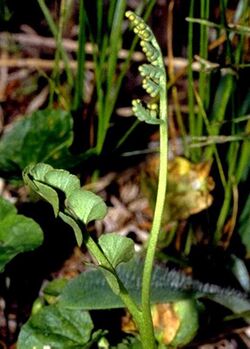Biology:Eusporangiate fern
| Eusporangiate ferns | |
|---|---|

| |
| Botrychium lunaria | |
| Scientific classification | |
| Kingdom: | Plantae
|
| Division: | |
| (unranked): | Eusporangiate ferns
|
| Classes | |
Eusporangiate ferns are vascular spore plants, whose sporangia arise from several epidermal cells and not from a single cell as in leptosporangiate ferns. Typically these ferns have reduced root systems and sporangia that produce large amounts of spores (up to 7000 spores per sporangium in Christensenia).
There are four extant eusporangiate fern families, distributed among three classes. Each family is assigned to its own order.[1][2]
- Class Psilotopsida
- Order Psilotales, family Psilotaceae – Whisk ferns (2 genera, about 17 species)
- Order Ophioglossales, family Ophioglossaceae – Adder's-tongues (5 genera, about 80 species)
- Class Equisetopsida
- Order Equisetales, family Equisetaceae – Horsetails (1 genus, about 15 species)
- Class Marattiopsida
- Order Marattiales, family Marattiaceae – Marattoid ferns (6 genera, about 500 species)
The following diagram shows a likely phylogenic placement of eusporangiate fern classes within the vascular plants.[3][4]
|
eusporangiate
ferns leptosporangiate ferns |
Cladistics
While it is generally accepted that the leptosporangiate ferns are monophyletic, it is considered to be likely that the eusporangiate ferns, as a group, are paraphyletic.[5] In each of the three examples from recently published studies, shown in the following table, it can be seen that, together, the four eusporangiate fern families do not form a single clade.
|
|
|
References
- ↑ Alan R. Smith; Kathleen M. Pryer; Eric Schuettpelz; Petra Korall; Harald Schneider; Paul G. Wolf (2006). "A classification for extant ferns". Taxon 55 (3): 705–731. doi:10.2307/25065646. http://www.pryerlab.net/publication/fichier749.pdf.
- ↑ Maarten J. M. Christenhusz; Xian-Chun Zhang; Harald Schneider (2011). "A linear sequence of extant families and genera of lycophytes and ferns". Phytotaxa 19: 7–54. doi:10.11646/phytotaxa.19.1.2. http://www.mapress.com/phytotaxa/content/2011/f/pt00019p054.pdf.
- ↑ Paul G. Wolf; Joshua P. Der; Jacob B. Davidson; Kathleen M. Pryer; Aaron M. Duffy; Amanda L. Grusz (2010). "The evolution of chloroplast genes and genomes in ferns". Plant Molecular Biology 76 (3–5): 251–261. doi:10.1007/s11103-010-9706-4. PMID 20976559. http://www.pryerlab.net/publication/fichier1277.pdf.[yes|permanent dead link|dead link}}]
- ↑ 4.0 4.1 Samuli Lehtonen (2011). "Towards Resolving the Complete Fern Tree of Life". PLOS ONE 6 (10): e24851. doi:10.1371/journal.pone.0024851. PMID 22022365. PMC 3192703. Bibcode: 2011PLoSO...624851L. http://www.sci.utu.fi/sivustot/amazon/publications/articles/pdf_pub/Lehtonen_2011_PLoS1.pdf.
- ↑ Kathleen M. Pryer; Eric Schuettpelz; Paul G. Wolf; Harald Schneider; Alan R. Smith; Raymond Cranfill (2004). "Phylogeny and evolution of ferns (monilophytes) with a focus on the early leptosporangiate divergences". American Journal of Botany 91 (10): 1582–1598. doi:10.3732/ajb.91.10.1582. PMID 21652310.
- ↑ Kathleen M. Pryer; Eric Schuettpelz (2009). "Ferns". The Timetree of Life. Oxford Biology. http://www.pryerlab.net/publication/fichier1177.pdf.
- ↑ Hardeep S. Rai; Sean W. Graham (2010). "Utility of a large, multigene plastid data set in inferring higher-order relationships in ferns and relatives (Monilophytes)". American Journal of Botany 97 (9): 1444–1456. doi:10.3732/ajb.0900305. PMID 21616899.
- Hogan, C.Michael. 2010. Fern. Encyclopedia of Earth, National Council for Science and the Environment. topic ed. Saikat Basu
- Sporne, K. R. 1962. The morphology of pteridophytes, the structure of ferns and allied plants. pp. 127–135. Hutchison & Co. London.
Wikidata ☰ Q2624762 entry
 |

